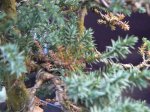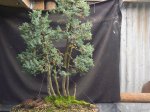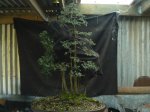Just how much work does it take to continue to develop a multi branched tree which just about finished high school?
There so many little jobs you have to repeat every year. It's all the boring and tedious jobs (where is Adiar? he loves doing this stuff) of development they often never mention at demonstrations. It might be interesting for the first hour or two but after that it's just plain work.
Here's an example of a tree requiring such work.
A root connected juniper.

The jobs include removing last year's wire, pulling all the old brown needles with tweezers one by one. (sometimes you get lucky and grab 2 or 3 at once), pruning the shoots to shorten them as much as possible. (Usually you need to do all of them), re-wiring each twig, and positioning.
Not to mention all the unforseen jobs that spring up.
Old needles, branches which have died back all need to be cleaned up thoroughly.

After 30 mins, the smallest easiest trunk is unwired, cleaned and re-wired.
And it doesn't even have that many branches on it. Next year it will probably take closer to one hour to complete.

After a while trunks can drift and move. At least the main trunk here needs to be straight and upright. With a normal forest it's simply a matter of propping it up at the roots but since these are all connected, it will need to be pulled. Also it has a bow so it will need to go right at the base and then left at the top.

In this case there is nothing to attach the guy wire to so I have hooked and run a heavy wire all the way from the middle drainage hole up the right side of the pot.

The main trunk pulled to the right....

There so many little jobs you have to repeat every year. It's all the boring and tedious jobs (where is Adiar? he loves doing this stuff) of development they often never mention at demonstrations. It might be interesting for the first hour or two but after that it's just plain work.
Here's an example of a tree requiring such work.
A root connected juniper.

The jobs include removing last year's wire, pulling all the old brown needles with tweezers one by one. (sometimes you get lucky and grab 2 or 3 at once), pruning the shoots to shorten them as much as possible. (Usually you need to do all of them), re-wiring each twig, and positioning.
Not to mention all the unforseen jobs that spring up.
Old needles, branches which have died back all need to be cleaned up thoroughly.

After 30 mins, the smallest easiest trunk is unwired, cleaned and re-wired.
And it doesn't even have that many branches on it. Next year it will probably take closer to one hour to complete.

After a while trunks can drift and move. At least the main trunk here needs to be straight and upright. With a normal forest it's simply a matter of propping it up at the roots but since these are all connected, it will need to be pulled. Also it has a bow so it will need to go right at the base and then left at the top.

In this case there is nothing to attach the guy wire to so I have hooked and run a heavy wire all the way from the middle drainage hole up the right side of the pot.

The main trunk pulled to the right....




